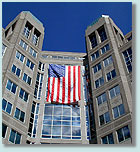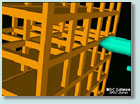| |
 |
 |
 |
|
 |
 |
 |
 |
 |

|
 |
 |
| |
 |
Researchers
Find Trigger for Devastating Digestive
Disease, Propose Treatment |
 |
| |
 Researchers
have found a peptide molecule that triggers
celiac sprue -- a severe inflammation
of the intestine that results from eating
wheat and related grains -- and propose
a treatment strategy that relies on bacterial
enzymes to break down the offending molecule
in the digestive tract. As many as 1 in
every 200 Americans suffers from the condition.
In the September 27 issue of Science,
Chaitan Khosla and his coworkers at Stanford
University and the University of Norway
in Oslo, report disassembling the large,
complex mixture of gluten proteins and
identifying a single component that triggers
the autoimmune response characteristic
of celiac sprue. Researchers
have found a peptide molecule that triggers
celiac sprue -- a severe inflammation
of the intestine that results from eating
wheat and related grains -- and propose
a treatment strategy that relies on bacterial
enzymes to break down the offending molecule
in the digestive tract. As many as 1 in
every 200 Americans suffers from the condition.
In the September 27 issue of Science,
Chaitan Khosla and his coworkers at Stanford
University and the University of Norway
in Oslo, report disassembling the large,
complex mixture of gluten proteins and
identifying a single component that triggers
the autoimmune response characteristic
of celiac sprue.
Read
the full story . ... posted
9/26/02
|
|
 |
Awards
Will Advance the State of Information
Technology's Art |
 |
| |
 The
National Science Foundation (NSF) will
support new approaches to software development
and computer networking and communications
that will in turn provide scientists with
entirely new ways of working with large
data sets, visualizing what the data represent
and sharing knowledge around the globe.
The grants were made under NSF's Information
Technology Research (ITR) program. From
the study of biological phenomena at the
cellular level to enhancing earthquake
prediction to efforts to advance the design
and development of "embedded" software
systems that help to run automobiles and
aircraft, the third year of ITR grants
will provide scientists with powerful
new analytical and communications tools.
They will also simultaneously advance
the state of the art in computer science. The
National Science Foundation (NSF) will
support new approaches to software development
and computer networking and communications
that will in turn provide scientists with
entirely new ways of working with large
data sets, visualizing what the data represent
and sharing knowledge around the globe.
The grants were made under NSF's Information
Technology Research (ITR) program. From
the study of biological phenomena at the
cellular level to enhancing earthquake
prediction to efforts to advance the design
and development of "embedded" software
systems that help to run automobiles and
aircraft, the third year of ITR grants
will provide scientists with powerful
new analytical and communications tools.
They will also simultaneously advance
the state of the art in computer science.
Read
the full story . ... posted
9/26/02
|
|
 |
NSF
Funds $10.2 Million Maize Gene Sequencing
Push |
 |
| |
 The
National Science Foundation (NSF) announced
on Sept. 20, 2002, the award of $10.2
million over two years to two projects
for initial sequencing of the Zea
mays (maize or corn) genome. The
maize genome offers a new sequencing challenge
because its size and structure preclude
use of the standard whole-genome methods
currently used. At about 2 billion base
pairs, the maize genome is estimated to
be 20 times larger than Arabidopsis,
the first complete plant genome to be
sequenced. However, maize probably has
only twice as many genes as Arabidopsis. The
National Science Foundation (NSF) announced
on Sept. 20, 2002, the award of $10.2
million over two years to two projects
for initial sequencing of the Zea
mays (maize or corn) genome. The
maize genome offers a new sequencing challenge
because its size and structure preclude
use of the standard whole-genome methods
currently used. At about 2 billion base
pairs, the maize genome is estimated to
be 20 times larger than Arabidopsis,
the first complete plant genome to be
sequenced. However, maize probably has
only twice as many genes as Arabidopsis.
Read
the full story . ... posted
9/26/02
|
|
 |
"Winfly"
Opens 2002-2003 Antarctic Research Season
|
 |
| |
 The
2002-2003 Antarctic research season officially
got underway in late August as U.S. Air
Force transport planes bested snowstorms
and high winds to bring in cargo and personnel
to McMurdo Station, the National Science
Foundation's logistical and scientific
hub on the continent. Dubbed "Winfly,"
the flights were the first to land at
McMurdo since the station closed for the
austral winter in February. The annual
Winfly missions allow the Antarctic program
to bring scientists into McMurdo at the
beginning of the austral spring to conduct
time-sensitive research, such as monitoring
ozone depletion. The
2002-2003 Antarctic research season officially
got underway in late August as U.S. Air
Force transport planes bested snowstorms
and high winds to bring in cargo and personnel
to McMurdo Station, the National Science
Foundation's logistical and scientific
hub on the continent. Dubbed "Winfly,"
the flights were the first to land at
McMurdo since the station closed for the
austral winter in February. The annual
Winfly missions allow the Antarctic program
to bring scientists into McMurdo at the
beginning of the austral spring to conduct
time-sensitive research, such as monitoring
ozone depletion.
Photo: Mike Hush / Raytheon Polar
Services Co.
Read
the full story . ... posted
9/17/02
|
|
 |
Interactive Robot Motivates Children
with Physical Disabilities |
 |
| |
 An
interactive robot named CosmoBotTM
is teaching children with speech, language
and other developmental disabilities how
to express themselves. Built to withstand
active play, CosmoBotTM looks
like a spunky sidekick from a science
fiction movie, with fully mobile appendages,
motorized wheels beneath its feet, and
a mouth that moves. The robot captures
attention by mimicking a child's movements
and voice, and can guide the child through
educational and therapeutic activities
under the direction of a therapist.The
robot was developed by Corinna Lathan
of AnthroTronix, Inc., in College Park,
Maryland, with support from the National
Science Foundation's (NSF) Small Business
Innovation Research (SBIR) Program and
the Department of Education's Rehabilitation
Engineering Research Center (RERC) on
Telerehabilitation. An
interactive robot named CosmoBotTM
is teaching children with speech, language
and other developmental disabilities how
to express themselves. Built to withstand
active play, CosmoBotTM looks
like a spunky sidekick from a science
fiction movie, with fully mobile appendages,
motorized wheels beneath its feet, and
a mouth that moves. The robot captures
attention by mimicking a child's movements
and voice, and can guide the child through
educational and therapeutic activities
under the direction of a therapist.The
robot was developed by Corinna Lathan
of AnthroTronix, Inc., in College Park,
Maryland, with support from the National
Science Foundation's (NSF) Small Business
Innovation Research (SBIR) Program and
the Department of Education's Rehabilitation
Engineering Research Center (RERC) on
Telerehabilitation.
Read
full story. ... posted
9/17/02
|
|
 |
September
11, 2002 — Patriot Day |
 |
| |
 The U.S. flag at half-staff at Amundsen-Scott,
the U.S. research station at the South
Pole, following the attacks on the World
Trade Center and the Pentagon one year
ago.
The U.S. flag at half-staff at Amundsen-Scott,
the U.S. research station at the South
Pole, following the attacks on the World
Trade Center and the Pentagon one year
ago.
Photo: Jerry Macala/National Science Foundation
... posted 9/11/02
|
|
 |
A
9/11 Message to the NSF Family |
 |
| |
 "On
this one-year anniversary of September
11, we all know that the events of that
day have changed America and Americans
forever. They have opened the box of the
unimaginable and released the unthinkable.
For the nation, its institutions, and
its citizens, there is a loss of innocence
about the security of our land and of
our lives. In its place, we find a new
vigilance for the unexpected," noted agency
Director Rita Colwell and Deputy Director
Joseph Bordogna in a message to NSF staff.
"On
this one-year anniversary of September
11, we all know that the events of that
day have changed America and Americans
forever. They have opened the box of the
unimaginable and released the unthinkable.
For the nation, its institutions, and
its citizens, there is a loss of innocence
about the security of our land and of
our lives. In its place, we find a new
vigilance for the unexpected," noted agency
Director Rita Colwell and Deputy Director
Joseph Bordogna in a message to NSF staff.
Photo: Peter West, National Science Foundation
Read
full message. ... posted
9/11/02
|
|
 |
People
Who "Gave Up" After 9/11 More Likely to
Remain Distressed |
 |
| |
 The
Sept. 11 attacks of 2001 left a lingering
psychological impact on the nation according
to new research published in the Sept.
11 issue of the Journal of the American
Medical Association (JAMA). While
17 percent of the U.S. population living
outside New York City reported symptoms
of posttraumatic stress two months following
the attacks, 6 percent continued to report
symptoms six months afterward. An NSF-funded
study led by Roxane Cohen Silver, professor
of psychology and social behavior at the
University of California, Irvine, was
unusual because it followed people who
were already taking part in an Internet
survey panel when the Sept. 11 attacks
occurred. Therefore, their mental and
physical health histories were known prior
to the tragedy. The study, Silver explains,
provides new insights into how mental
health workers can help people who have
experienced trauma, and dispels a number
of myths about who might be most affected
by such an event. The
Sept. 11 attacks of 2001 left a lingering
psychological impact on the nation according
to new research published in the Sept.
11 issue of the Journal of the American
Medical Association (JAMA). While
17 percent of the U.S. population living
outside New York City reported symptoms
of posttraumatic stress two months following
the attacks, 6 percent continued to report
symptoms six months afterward. An NSF-funded
study led by Roxane Cohen Silver, professor
of psychology and social behavior at the
University of California, Irvine, was
unusual because it followed people who
were already taking part in an Internet
survey panel when the Sept. 11 attacks
occurred. Therefore, their mental and
physical health histories were known prior
to the tragedy. The study, Silver explains,
provides new insights into how mental
health workers can help people who have
experienced trauma, and dispels a number
of myths about who might be most affected
by such an event.
Read
full story. ... posted
9/11/02
|
|
 |
Model
of Plane Impact at WTC Provides Clues
to Structural Issues |
 |
| |
 Abolhassan
Astaneh-Asl, a civil engineering professor
at the University of California, Berkeley,
has constructed a realistic computer simulation
of the World Trade Center North Tower
being hit by a jet airplane. Astaneh's
model has simulated the first few seconds
of the plane's impact and entry into the
building, and he is refining the model
to include damage to the plane, the building
floors and the internal core columns.
The next step will be to include the effect
of fire heating the damaged structure
and initiating its final collapse.The
simulation will help researchers analyze
the potential effects that different structural
designs, such as more robust core walls
or more fireproofing, might have had and
the implications for the design of future
buildings. Abolhassan
Astaneh-Asl, a civil engineering professor
at the University of California, Berkeley,
has constructed a realistic computer simulation
of the World Trade Center North Tower
being hit by a jet airplane. Astaneh's
model has simulated the first few seconds
of the plane's impact and entry into the
building, and he is refining the model
to include damage to the plane, the building
floors and the internal core columns.
The next step will be to include the effect
of fire heating the damaged structure
and initiating its final collapse.The
simulation will help researchers analyze
the potential effects that different structural
designs, such as more robust core walls
or more fireproofing, might have had and
the implications for the design of future
buildings.
Image courtesy: Abolhassan Astaneh-Asl,
Univ. of Calif., Berkeley
Read
full story. ... posted
9/11/02
|
|
 |
NSF,
Intelligence Community to Cooperate On
"Data Mining" Research |
 |
| |
 The
intelligence community will provide as
much as $8 million to supplement existing
NSF research into methods of extracting
underlying patterns -- and even developing
predictive abilities -- from enormous
sets of data such as television broadcasts
and Web pages. The researchers who will
receive the funding already were tackling
aspects of those problems. But last September's
terrorist attacks have lent their work
much greater immediacy, noted Peter Freeman,
assistant director for NSF's Directorate
for Computer & Information Sciences
and Engineering (CISE). The
intelligence community will provide as
much as $8 million to supplement existing
NSF research into methods of extracting
underlying patterns -- and even developing
predictive abilities -- from enormous
sets of data such as television broadcasts
and Web pages. The researchers who will
receive the funding already were tackling
aspects of those problems. But last September's
terrorist attacks have lent their work
much greater immediacy, noted Peter Freeman,
assistant director for NSF's Directorate
for Computer & Information Sciences
and Engineering (CISE).
Read full
story.... posted
9/11/02
Read
more about NSF and Homeland Security
|
|
 Top of Page Top of Page
|
|
|
 |
 |
 |
 |
 |
 |
 |
 |
|
 |
 |
 |
|
|
| |
|
|
| |
 |
National Science Foundation
Office of Legislative and Public Affairs
4201 Wilson Boulevard
Arlington, Virginia 22230, USA
Tel: 703-292-8070
FIRS: 800-877-8339 | TDD: 703-292-5090
|
 |
|
|
|

